|
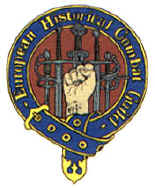
European
Historical Combat Guild
Inaugural Seminar 2001
at the Royal Armouries Museum, Leeds UK
Report by J.
Clements
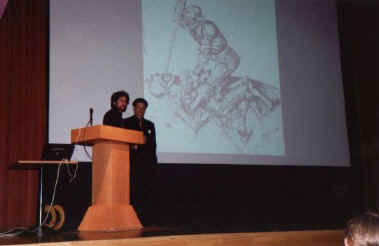 Attending the Royal Armouries
seminar held by the European Historical Combat Guild (EHCG) August 4th &
5th in Leeds was extraordinary. Never before has there been such a Medieval &
Renaissance martial arts event of this kind: a gathering of first-class historians,
scholars, academics, curators, conservationists, medievalists, re-enactors, and martial
artists –held in the largest arms museum in the world no less. We were surrounded by
all manner of real swords, armor, and weapons as well as having samples to examine on
hand. Attending the Royal Armouries
seminar held by the European Historical Combat Guild (EHCG) August 4th &
5th in Leeds was extraordinary. Never before has there been such a Medieval &
Renaissance martial arts event of this kind: a gathering of first-class historians,
scholars, academics, curators, conservationists, medievalists, re-enactors, and martial
artists –held in the largest arms museum in the world no less. We were surrounded by
all manner of real swords, armor, and weapons as well as having samples to examine on
hand.
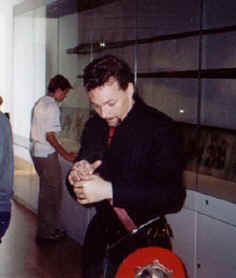 The
lectures and presentations were fascinating and first rate. It was
quite a site to see more than 80 international participants from seven
countries practicing with all manner of weapons. The future trends
of Medieval and Renaissance martial arts also a major topic of discussion
as was current study and training methods. ARMA was warmly received
by everyone we met. We
were sincerely honored to have been specially invited to present at
such an event and we noted with modesty that for many our reputation
for skillful display had preceded us. The
lectures and presentations were fascinating and first rate. It was
quite a site to see more than 80 international participants from seven
countries practicing with all manner of weapons. The future trends
of Medieval and Renaissance martial arts also a major topic of discussion
as was current study and training methods. ARMA was warmly received
by everyone we met. We
were sincerely honored to have been specially invited to present at
such an event and we noted with modesty that for many our reputation
for skillful display had preceded us.
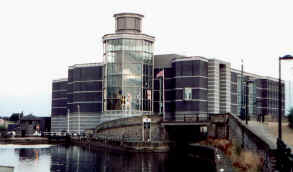 The
custom built Royal Armouries Museum located in West Yorkshire, England, is the
world’s foremost museum of arms and armour. Over four stories of weapons and
associated artifacts fill floors dedicated to warfare, tournaments, self-defense, and
hunting.
The Armories hosts an extraordinary diverse collection of all periods including some
exceptionally rare examples of swords and samples of armor. Dynamic
displays, video screens, and informative graphics convey arms and armor as practical tools
not mere artistic or cultural objects. Topping
off the uniqueness of the Royal Armories effort at education and entertainment is their
original Fight Interpretation Team (headed by John Waller) offering realistic live
performances of arranged combat sequences derived from the historical manuals and
individual research.
The fight interpretations have a well-earned reputation for accuracy. The Royal Armouries
own official statement declares it is convinced of the value of teaching through
demonstration and performance and of learning through participation and doing. Master of the Armories, Guy Wilson, explained he
was delighted to host this inaugural seminar of the Guild and wished the Guild a long and
active life. The
custom built Royal Armouries Museum located in West Yorkshire, England, is the
world’s foremost museum of arms and armour. Over four stories of weapons and
associated artifacts fill floors dedicated to warfare, tournaments, self-defense, and
hunting.
The Armories hosts an extraordinary diverse collection of all periods including some
exceptionally rare examples of swords and samples of armor. Dynamic
displays, video screens, and informative graphics convey arms and armor as practical tools
not mere artistic or cultural objects. Topping
off the uniqueness of the Royal Armories effort at education and entertainment is their
original Fight Interpretation Team (headed by John Waller) offering realistic live
performances of arranged combat sequences derived from the historical manuals and
individual research.
The fight interpretations have a well-earned reputation for accuracy. The Royal Armouries
own official statement declares it is convinced of the value of teaching through
demonstration and performance and of learning through participation and doing. Master of the Armories, Guy Wilson, explained he
was delighted to host this inaugural seminar of the Guild and wished the Guild a long and
active life.
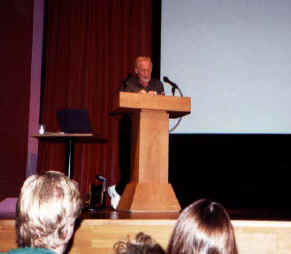 The event opened Saturday morning in the Royal
Armouries’ Bury Theatre with Head of Fight Interpretation and Guild Master, John
Waller, welcoming everyone and expressing how special the seminar was in being the very
first held in a major arms collection. John
Waller gave the opening remarks commenting on the great changes he has seen in the subject
since he began with it over 30 years ago, with the access to the historical manuals and
the intensity of efforts by so many individuals. He noted how successful the new Guild
movement has been and its unique position is associated the armories. John Waller
stressed the need in the historical fencing community for “honor” and an end to
“petty ego politics”. John Waller’s goal behind the seminar was aimed at
bringing together individuals or groups which share a belief in, and practice of the
philosophies advocated by the Guild, whilst learning or teaching European Historical
Combat. The event offered the chance to stimulate the exchange of knowledge and discussion
between academics and practitioners to improve the understanding of European historical
combat, plus exchange ideas with and benefit from the expertise offered by Guild teachers. The event opened Saturday morning in the Royal
Armouries’ Bury Theatre with Head of Fight Interpretation and Guild Master, John
Waller, welcoming everyone and expressing how special the seminar was in being the very
first held in a major arms collection. John
Waller gave the opening remarks commenting on the great changes he has seen in the subject
since he began with it over 30 years ago, with the access to the historical manuals and
the intensity of efforts by so many individuals. He noted how successful the new Guild
movement has been and its unique position is associated the armories. John Waller
stressed the need in the historical fencing community for “honor” and an end to
“petty ego politics”. John Waller’s goal behind the seminar was aimed at
bringing together individuals or groups which share a belief in, and practice of the
philosophies advocated by the Guild, whilst learning or teaching European Historical
Combat. The event offered the chance to stimulate the exchange of knowledge and discussion
between academics and practitioners to improve the understanding of European historical
combat, plus exchange ideas with and benefit from the expertise offered by Guild teachers.
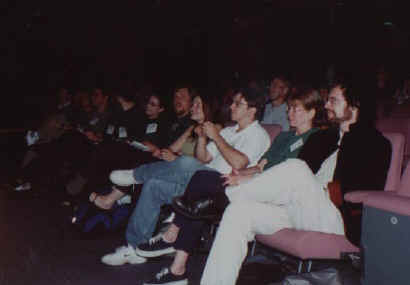 This was followed with the first presentation, an
aptly named lecture “Fence and Insensibility”, by Jeffrey Forgeng, Professor of
Humanities and Paul S. Morgan Curator at the Higgins Armoury Museum in Worchester
Massachusetts. Jeffrey Forgeng set the tone for the weekend by offering an original and
highly effective viewpoint for interpreting the works of historical martial arts.
“Anyone who has worked with historical martial arts manuals knows that recreating
their techniques is often like listening to a train station loudspeaker for instructions
for a game of Twister.” His presentation looked at some of the difficulties
posed by the historical texts and various ways of dealing with them. A slide show conveyed
some of the difficulty of going from text and pictures of the manuals to translations of
them and then to interpretation and practicum. Offering much to consider, it focused on
examples from the Walpurgis Fechtbuch (Royal Armouries MS I.33) and Joachim
Meyer’s treatise of 1570. We feel his approach gave us in particular a very useful
tool and we have plans now to adopt much of his ideas in our own study of the manuals.
Interestingly, as it happened Jeffrey Forgeng’s lecture material was also very
complimentary to the content our own presentation the following day. This was followed with the first presentation, an
aptly named lecture “Fence and Insensibility”, by Jeffrey Forgeng, Professor of
Humanities and Paul S. Morgan Curator at the Higgins Armoury Museum in Worchester
Massachusetts. Jeffrey Forgeng set the tone for the weekend by offering an original and
highly effective viewpoint for interpreting the works of historical martial arts.
“Anyone who has worked with historical martial arts manuals knows that recreating
their techniques is often like listening to a train station loudspeaker for instructions
for a game of Twister.” His presentation looked at some of the difficulties
posed by the historical texts and various ways of dealing with them. A slide show conveyed
some of the difficulty of going from text and pictures of the manuals to translations of
them and then to interpretation and practicum. Offering much to consider, it focused on
examples from the Walpurgis Fechtbuch (Royal Armouries MS I.33) and Joachim
Meyer’s treatise of 1570. We feel his approach gave us in particular a very useful
tool and we have plans now to adopt much of his ideas in our own study of the manuals.
Interestingly, as it happened Jeffrey Forgeng’s lecture material was also very
complimentary to the content our own presentation the following day.
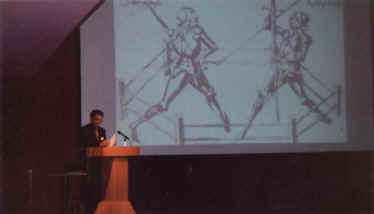 After this, a second lecture was given by Tobias
Capwell, BA, MA, MA, of the University of Leeds medieval studies program. Tobias is an
accomplished jouster and also a member of Mike Loades’ Historical Action group. His
presentation on “15th-century pictorial depiction of European fighting
arts” was lively, informative, and entertaining. He presented several original ideas
and stressed that while much of the modern understanding of Medieval and Renaissance
fighting skills has been derived from surviving manuals, these manuscripts are not the
only source of information available. After this, a second lecture was given by Tobias
Capwell, BA, MA, MA, of the University of Leeds medieval studies program. Tobias is an
accomplished jouster and also a member of Mike Loades’ Historical Action group. His
presentation on “15th-century pictorial depiction of European fighting
arts” was lively, informative, and entertaining. He presented several original ideas
and stressed that while much of the modern understanding of Medieval and Renaissance
fighting skills has been derived from surviving manuals, these manuscripts are not the
only source of information available.
He gave considerable evidence from 15th century artwork that
contemporary artists displayed a keen interest in the realistic portrayal
of combat at close quarters. The aim of his talk was to examine a
cross-section of some of the most interesting examples of the period
and to consider the implications of their evidence. Capwell stressed
the problem with art historians labeling historical combat depictions
as “fantastical” based solely on their own highly limited
and often quite faulty understandings of the actual function of historical
arms and armor. Many period artists actually included
technical details in their works that conveyed authority and underscored
the authenticity of often pseudo-historical (and sometimes fantastical)
subject matter. A fascinating slide show of examples relating Fiore
Dei Liberi’s techniques to those found in wall frescoes was illuminating.
Just as with Jeffrey Forgeng’s, Tobias’ lecture also coincidentally
fit very nicely with the material ARMA presented the next day.
Tobias made a strong impact by showing the
importance of pictorial evidence. It was an excellent and revealing
presentation of the understated relationship between period artwork
and the manuals. He discussed the problem of period artwork not considered
evidence or reliable having often been dismissed as "artistic
license". He noted doing so severely limits our range, size,
and depth of research, and that it is wrong to discount artists depiction
of their environment. Intriguingly, he addressed how the problem of
how to use art in manuals to enhance our practice is actually the
very same as their actual historical purpose (which he called “a
rare alignment of historical and of modern use” --something that
seldom occurs in historical studies, pointing out for example, that
Medieval prayer books in contrast are seldom used by modern Christian
to pray). Finnaly, Tobias brought up an important question which must
be our very first in regard to artwork in the manuals: how realistic
is this? He compared material in the Getty edition of Fiore Dei
Liberi’s Flos Duellatorum with contemporary frescoes by
the painter/muralist Aretino Spinello of Arezzo. The very same dagger and wrestling
moves could be discerned. He
also pointed out where both Fiore’s and Talhoffer’s mounted
combat techniques appeared in Veronese drawings and Burgundian tapestries.
| 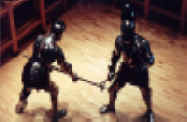
|
Following a
break, many attendees went to observe a vigorous fight interpretation of “Polaxe
fighting in Tonlet armour” in the Tournament Gallery. Tonlet armor is the full
“skirt-like” plate harness for foot combat. The display was the most energetic
and martially-sound depiction of the use of the polaxe we had ever witnessed. The performance was run through once as an
arranged fight sequence and then again broken down by action to explain to spectators the
techniques and actions as well as possible options and counters the fighters would have.
This familiar style of the Royal Armories fight interpretations is quiet effective in
conveying general information to the public as well as teaching practitioners. |
|
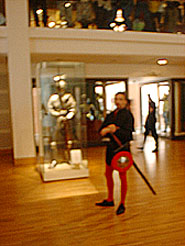
|
After a mass luncheon
assault in the Royal Armories café and a raid on the gift shop, some attendees went to
view the optional Yabusame demonstration of samurai mounted-archery put on by guests from
a shrine in Japan. Then the major portion of practical Guild training began in the Royal
Armouries Hall. This consisted of basic training for non-members and beginners and
syllabus and grading for current Guild members. |
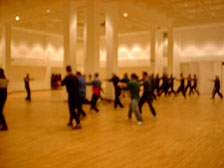 More than 60 fighters using everything from short swords to
great swords to rapier and dagger took to the floor of the great two-story events hall for
a mass session (the small photo at right does not do justice to the scene). Dozens of
spectators stood or sat off to side watching the sweat. Several hours of instruction was
given by John and Jonathan Waller in the Guild fighting method. They stressed the factors that determine the way
in which a combat takes place and their philosophy of teaching and beliefs such as:
contact, balance, and intent. John
Waller’s system is based on principles many of which are borne out by European
fighting manuals and martial arts around the world. Instruction placed emphasis on body
mechanics, weapons used, clothing/protection, environment, and intention. More than 60 fighters using everything from short swords to
great swords to rapier and dagger took to the floor of the great two-story events hall for
a mass session (the small photo at right does not do justice to the scene). Dozens of
spectators stood or sat off to side watching the sweat. Several hours of instruction was
given by John and Jonathan Waller in the Guild fighting method. They stressed the factors that determine the way
in which a combat takes place and their philosophy of teaching and beliefs such as:
contact, balance, and intent. John
Waller’s system is based on principles many of which are borne out by European
fighting manuals and martial arts around the world. Instruction placed emphasis on body
mechanics, weapons used, clothing/protection, environment, and intention.
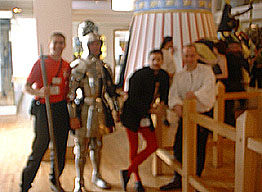
|
All
weapons training in the Guild is designed to encourage students
to become aware of their body’s responses in attack and
defence and how these responses can be controlled and each
student is assessed on an individual basis, with techniques
taught suiting their particular physicality.
ARMA took part in the classes cross-training while
I observed the action, engaged in countless fascinating conversations
with researchers and fellow students, and tried in vane to
find the time to actually roam some of the weapon collection.
It was an added delight at the seminar to finally meet several
people of which we had known only through email and the Internet,
and to make the acquaintance of many new colleagues.
|
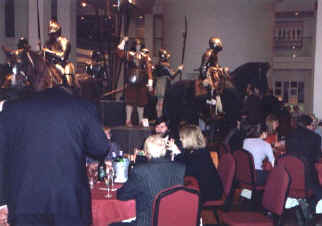 Saturday night concluded with a formal coat and tie
reception in the Armouries’ Tournament Gallery and a private dinner in the War
Gallery. The cuisine was excellent, the event
festive, the companionship pleasant, the conversation vibrant, and the surroundings
–actual armor and weapons displays –extraordinary. Saturday night concluded with a formal coat and tie
reception in the Armouries’ Tournament Gallery and a private dinner in the War
Gallery. The cuisine was excellent, the event
festive, the companionship pleasant, the conversation vibrant, and the surroundings
–actual armor and weapons displays –extraordinary.
We enjoyed the company of more than 60 of our fellows as well as the arms
collection. We had the opportunity to chat at length with Guy Wilson,
Master of the Armouries, on military history, arms conservation, and
the museum’s philosophy, fight interpretation program, and exciting
future plans. Following the dinner for many attendees was a night
on the town to indulge in some of Leed’s youthful nightlife.
On Sunday, the seminar continued opening with a lecture
on the main stage by ARMA on “Medieval Long-sword of the Italian
and German Masters”, followed by examples of Renaissance dagger
fighting and grappling techniques.
I started out discussing the term “martial arts”
and the current revival of historical European fighting skills, relating
them both to not only the period practices of the manuals but also
earlier Victorian interest in the subject. This was followed by a
short example of the ARMA Study Approach and Training Methodology
emphasizing the ideal of Ernst Fechten and the component of
emotional content. Jeff and myself then gave an energetic demonstration
of some fundamental long-sword Floryshes using steel blunts
and wasters. From here, a presentation on the four basic guards of
Liechtenauer and their modifications in the Italian school was given. Some basic half-swording was also
worked into this.
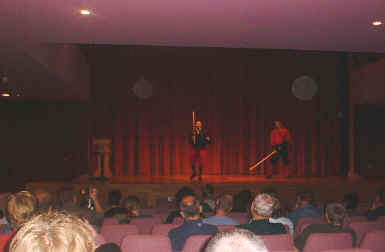
ARMA
presentation
|
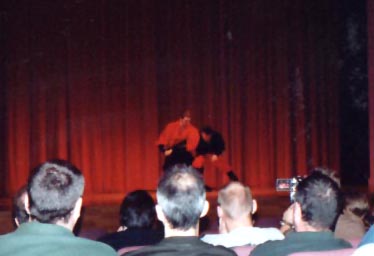
dagger
work
|
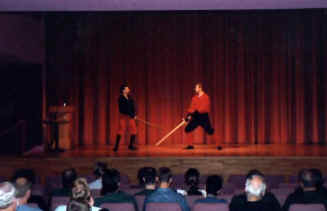 We then demonstrated an extended example of basic counters
to fundamental cuts, explaining the principle behind each technique,
we then showed some half-swording and our special close-in Schwertnemen
and gioco stretto which our method has become known for.
We then changed gears and to the audience’s delight Jeff
expertly displayed several highly effective and formidable preses
and counters to dagger thrusts and stabbing attacks, followed by several
more unarmed defenses against dagger strikes.
He countered, trapped, disarmed, or arm-locked me while employing
takedowns or seizing holds. We even managed some impromptu counters
and variations to keep things unpredictable. The whole time we presented
our material in a causal and frequently humorous manner, but stressed
the seriousness of the historical purpose behind the craft. The material was also pleasantly tied
back into the prior day’s lectures by Messrs. Forgeng and Capwell,
in many ways bringing it all back full circle. We then demonstrated an extended example of basic counters
to fundamental cuts, explaining the principle behind each technique,
we then showed some half-swording and our special close-in Schwertnemen
and gioco stretto which our method has become known for.
We then changed gears and to the audience’s delight Jeff
expertly displayed several highly effective and formidable preses
and counters to dagger thrusts and stabbing attacks, followed by several
more unarmed defenses against dagger strikes.
He countered, trapped, disarmed, or arm-locked me while employing
takedowns or seizing holds. We even managed some impromptu counters
and variations to keep things unpredictable. The whole time we presented
our material in a causal and frequently humorous manner, but stressed
the seriousness of the historical purpose behind the craft. The material was also pleasantly tied
back into the prior day’s lectures by Messrs. Forgeng and Capwell,
in many ways bringing it all back full circle.
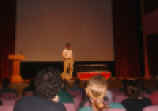 Continuing
from our session was a lecture on “Swords in the Royal Armouries
collection” by Graeme Rimer, Head of Collections at the Royal
Armouries Museum. Mr.
Rimer began with an onscreen presentation show covering the Armouries’
history and its collection as well as the move five years ago from
the Tower of London to the new facility in Leeds. He described the Armouries' extensive
sword collection covering both European and Oriental material from
the early Middle Ages to the 20th century. Continuing
from our session was a lecture on “Swords in the Royal Armouries
collection” by Graeme Rimer, Head of Collections at the Royal
Armouries Museum. Mr.
Rimer began with an onscreen presentation show covering the Armouries’
history and its collection as well as the move five years ago from
the Tower of London to the new facility in Leeds. He described the Armouries' extensive
sword collection covering both European and Oriental material from
the early Middle Ages to the 20th century.
Mr.
Rimer also discussed the unique philosophy behind the Armouries’ presentation of arms
and armor and then for everyone’s delight presented several pieces from the closed
collection with the opportunity for delegates to inspect, handle, and discuss them. The pieces included several varieties of 18th
and 19th century sabers and cutlasses, a lovely great-sword blade from c. 1400
(but with an awful 19th century replacement hilt), a long German swept-hilt
rapier and a very long Spanish cup-hilt rapier both of c. 1600. Each of the long rapiers
had fairly wide but very rigid blades, were light, very well-balanced, and entirely dull
–in the sense of a true cutting edge as on the great sword or sabers. Attendees in white gloves swarmed around the
pieces, hefting them, passing them from hand to hand and remarking on their minute details
and characteristics. For most it was their
very first time holding a real antique sword. After the sword viewing, a dynamic and rather vicious
fight interpretation on “armoured hand-and-a-half sword techniques” was
lead by Keith Ducklin in the Tournament Gallery. This was followed by the second session
of sweat-inducing Guild practical training in the
Royal Armouries Hall. The day ended later with grading presentations for Guild members and
a warm farewell by John and Jonathan Waller.
The RA's Fight Interpretors
Spending time later in the
interpreter’s “locker room” helping friend and Senior Fight Interpreter
Keith Ducklin with his harness also gave Jeff and I the chance to acquire an astounding
amount of information on the wearing and use of real armor.
We examined closely their arrangement of gambesons, arming caps, ties, mail
gussets, footwear, etc. It was an invaluable learning opportunity for us and we took a lot
of photos and notes. One of the greatest assets of the Royal Armories fight interpreters
is the astounding amount of extremely subtle information they have accumulated in regard
to the function and wearing of historically accurate armor. We noticed that perhaps
because the fight interpreters have been so intensely close to the subject on virtually a
daily basis, they are not really aware of the uniqueness and value of some of the
information they possess. We realized this on
our earlier visit to the Armouries in 1999. So,
in our discussions with them we tried to express our observations on just how unique we
felt their information was. The experience they have gathered from fighting almost
daily for years on end has given them a profound level of information that I do not
believe they fully realize the significance of. They
hold a subtle knowledge base acquired from countless insights into the design and wearing
of accurate harness and handling of antique weapons combined with experiment in historical
fighting techniques.
We discerned very quickly
they possess an exceptional degree of tips, advice, and insight on a range of subjects
such as: the actual strapping and belting of real armor, the proper placement and
functioning of arming points, the actual design of gambesons and arming coats, the wearing
of under garments, the purpose behind obscure design elements and how all of this relates
directly to practical issues of movement, comfort, and functionality. This kind of
information just can not be gained by weekend re-enactment, partially accurate armors, or
book research alone. We realized it can only be accumulated by people in their unique and
enviable position to work daily at historical combat amidst a huge collection of armor and
weapons, an extensive private library, have a wide array of personalized harnesses to play
in, have access to expert modern armorers and a staff of arms curators, and the opportunity to inspect and examine actual
historical pieces. Additionally, the humility
with which they express their opinions in spite of the above cannot help but earn our
respect. This is yet another reason ARMA values its special relationship with the Royal
Armouries and the John Waller’s Guild.
ARMA Wallace Demo & London
Research
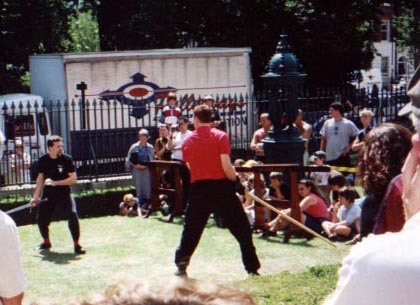 The Leeds event was not our only excitement. Earlier in the week, at the invitation of curator, conservationist,
and re-enactor David Edge, Jeff and I conducted a special one-hour
demonstration of Medieval German and Italian long-sword and dagger
fighting at the famed Wallace Collection Museum in London. After viewing
swords and armor in the collection the day before and again that morning,
we gave a display that, because of the size of the crowd of about
75 people, ended up having to be done on the front lawn outside of
the museum (which then attracted an even large number of spectators!). The Leeds event was not our only excitement. Earlier in the week, at the invitation of curator, conservationist,
and re-enactor David Edge, Jeff and I conducted a special one-hour
demonstration of Medieval German and Italian long-sword and dagger
fighting at the famed Wallace Collection Museum in London. After viewing
swords and armor in the collection the day before and again that morning,
we gave a display that, because of the size of the crowd of about
75 people, ended up having to be done on the front lawn outside of
the museum (which then attracted an even large number of spectators!).
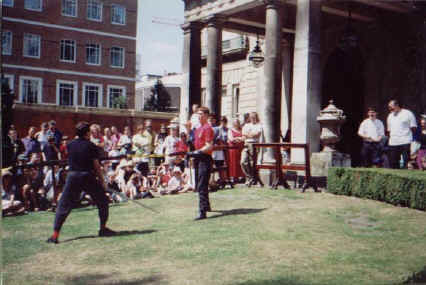 It was a hot summer day for London, but being from Texas we barely noticed,
and gave it our best. The display went well and despite the absence
of David Edge due to an emergency appendectomy (!) –from which
he will fully recover –we were especially pleased a special viewing
spot was made for Dr. Sydney Anglo (whom I am happy to announce
is now our official Advisor and has already begun reviewing our website’s
material for accuracy). It was a hot summer day for London, but being from Texas we barely noticed,
and gave it our best. The display went well and despite the absence
of David Edge due to an emergency appendectomy (!) –from which
he will fully recover –we were especially pleased a special viewing
spot was made for Dr. Sydney Anglo (whom I am happy to announce
is now our official Advisor and has already begun reviewing our website’s
material for accuracy).
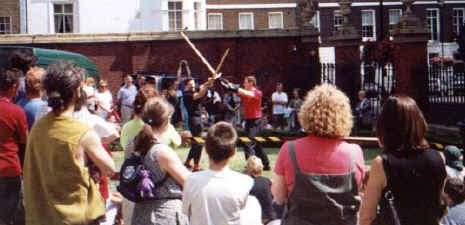
We were also excited while in London to finally meet our colleagues in the
Exiles group, who attended the Wallace demo. We were fortunate
to discuss a few aspects about translation and interpretation of Fiore
dei Liberi’s Flos Duellatorum with them. This was an added
pleasure as the Exiles are doing what we now believe is very likely
the foremost work on Fiore and have without question the most accurate
interpretation and translation we have encountered. In just casual
conversation and quick demonstration we were quite impressed with
the sophistication shown in their understanding of the Fiore material.
Even during consultation on Fiore with Dr. Anglo himself, he remarked
from just his brief conversation with the Exiles that day that he
was “quite impressed” and declared they appear to be doing
“very good work”. We were disappointed we were unable to
talk at length with Rob Lovett and Matt Easton, the Exiles leaders,
or see in detail their skills, but it is high on our list for next
time and we look forward to further consultation and collaboration
with them on their Fiore efforts. 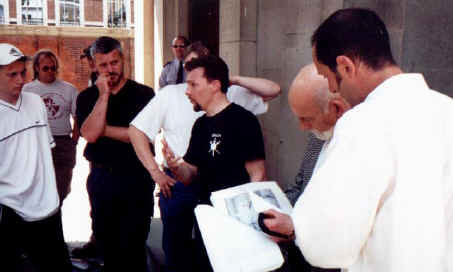 Research
wise, the trip was extraordinary fruitful for us. Not only did we
gather extensive notes from the seminar presentations, we pursued
several other avenues of investigation, We were able to spend several
productive hours in the new Erand Library at the Wallace Collection
(poised to become the center of arms and armor and historical fencing
research in London). Research
wise, the trip was extraordinary fruitful for us. Not only did we
gather extensive notes from the seminar presentations, we pursued
several other avenues of investigation, We were able to spend several
productive hours in the new Erand Library at the Wallace Collection
(poised to become the center of arms and armor and historical fencing
research in London).
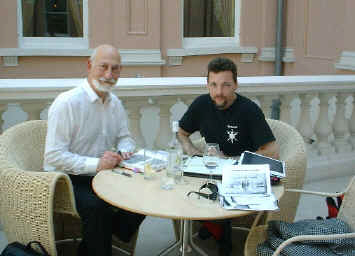 Under curator David Edge’s
direction, the Wallace library has in excess of 400 titles on arms and armor, including
whole shelves of works in French, German, Spanish, Swedish, Russian, Polish and other
eastern European languages. I also was
ecstatic to be able to spend several fascinating hours consulting with Dr. Sydney Anglo,
Dr. Anglo and I talked at length about his recent book, The Martial Arts of Renaissance
Europe, and the historical manuals, as well as my current areas of research in them. I
then visited the British Library’s rare book reading room with Dr. Anglo and was able
to spend the entire day and part of the evening conducting specific research. I examined
several original editions of period fencing manuals, collected some remarkable material,
and even made several discoveries. Upon our arrival in Leeds Jeff and I spent Friday at
the armories engaging in conversation with the fight interpreters and then spending
considerable time in the Royal Armories’ own library collecting an additional range
of rare material. Under curator David Edge’s
direction, the Wallace library has in excess of 400 titles on arms and armor, including
whole shelves of works in French, German, Spanish, Swedish, Russian, Polish and other
eastern European languages. I also was
ecstatic to be able to spend several fascinating hours consulting with Dr. Sydney Anglo,
Dr. Anglo and I talked at length about his recent book, The Martial Arts of Renaissance
Europe, and the historical manuals, as well as my current areas of research in them. I
then visited the British Library’s rare book reading room with Dr. Anglo and was able
to spend the entire day and part of the evening conducting specific research. I examined
several original editions of period fencing manuals, collected some remarkable material,
and even made several discoveries. Upon our arrival in Leeds Jeff and I spent Friday at
the armories engaging in conversation with the fight interpreters and then spending
considerable time in the Royal Armories’ own library collecting an additional range
of rare material.
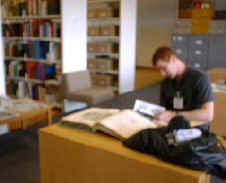 One exciting thing I
have to mention at this time is an Italian rapier manual written by a commoner which
offers evidence the rapier was indeed a street-fighting weapon of all classes. The work
also contains some of the most intriguing examples of grappling and wrestling techniques
in Renaissance swordplay. Another exciting item I
came across which I will write more about soon is a largely unknown 17th
century English work on the rapier written by a nobleman.
It offers vindication of several personal theories I have about gripping
rapiers and cutting, which in fact I have been teaching for several years. One exciting thing I
have to mention at this time is an Italian rapier manual written by a commoner which
offers evidence the rapier was indeed a street-fighting weapon of all classes. The work
also contains some of the most intriguing examples of grappling and wrestling techniques
in Renaissance swordplay. Another exciting item I
came across which I will write more about soon is a largely unknown 17th
century English work on the rapier written by a nobleman.
It offers vindication of several personal theories I have about gripping
rapiers and cutting, which in fact I have been teaching for several years.
 Additionally, we acquired
information on yet another previously unknown
anonymous German manual of over 600 pages and illustrated (!). We also learned of a newly discovered collection
of over 200 fencing books, mostly 18th century but with 20-30 17th
century works, that will be made public within the next year. Additionally, we learned of still another large
private collection of more than 2000+ fencing books (the third of its kind in Europe so
far). Additionally, we acquired
information on yet another previously unknown
anonymous German manual of over 600 pages and illustrated (!). We also learned of a newly discovered collection
of over 200 fencing books, mostly 18th century but with 20-30 17th
century works, that will be made public within the next year. Additionally, we learned of still another large
private collection of more than 2000+ fencing books (the third of its kind in Europe so
far).
Overall, our trip and the
event was an invaluable opportunity for us and we hope to soon present
online some of what we gathered in a form useful for students. We
are grateful for ARMA having been given the honor of an invitation
by the Royal Armories and the recognition of our work by the Guild.
Thanks to our respected friends and hosts within the Guild we enjoyed
an exceptional degree of camaraderie.
The seminar was exceptional. John and Jonathan Waller as well
as the entire Guild staff along with the Armouries are to be commended
for having successfully presented what was the most significant event
of its kind.
Back to
Spotlight |

